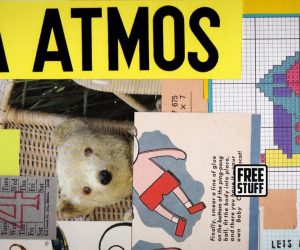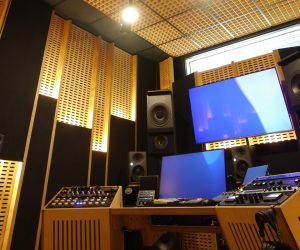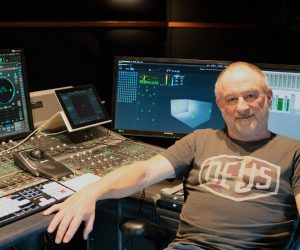
Atmos Music Mixing with Bob Clearmountain
Legendary mix engineer, Bob Clearmountain, is as in demand as ever, thanks to Apple’s decision to prioritise spatial music on its Music platform.
Interview: Christopher Holder
If you’re lucky enough to have an Atmos space to mix and/or listen to music then you’ll be aware that Atmos Music mixes vary wildly in quality from the sublime to the ridiculous.
Listen to enough spatial mixes (especially remixes of classic albums) and you’ll begin to pick a Bob Clearmountain mix. A Bob Clearmountain spatial mix distinguishes itself thanks to its great taste. The intent of the original mix and the artist is retained. It’s not a stereo mix that’s been flayed – with constituent parts strewn around the room. Sure, the mix has more space to move but not at the expense of the song.
AudioTechnology had the chance to sit down with Bob prior to the NAMM show in February. We videoed the interview and you can find it on YouTube here.
The full interview goes into some depth about how Bob customised his SSL G Series console to accommodate spatial workflow, which is all best heard straight from the horse’s mouth. Here I thought we could hear from Bob about what makes a good spatial mix and some of his creative process.
TIP TOEING WITH INTENT
AT: What makes for a good Atmos mix as a listener?
Bob Clearmountain: It’s got to be musical just like a good stereo mix. There can’t be anything in it that distracts you from the narrative of the song – whatever the artist is trying to convey in the song. In that regard it’s no different to a stereo mix but obviously things are coming out of different speakers. There are ways to do it that aren’t distracting; that are musical; that really work, where you have something appear in another speaker but it isn’t stepping on the toes of something important happening in the front.
I usually rely on the centre speaker quite a bit, which a lot of people don’t. A lot of people avoid it, because they’re used to a phantom centre. And I think that’s one of the great things about Atmos. If you put the singer in the centre speaker, it’s more like they’re in the room with you. And, not only that, it keeps the focus regardless of where you are in the room.
I’ll do a mix and I’ll walk around the room. It can’t just sound good in the sweetspot. Many people will put the same signal in several speakers in an attempt to pull the sound into the room. That’s fine if you’re sitting in the middle but what if you’re not? It can fall apart.
AT: If you’ve been tasked with turning an existing stereo mix into a spatial one, what’s your workflow?
Bob Clearmountain: If it’s something that’s been mixed before – whether I did it or somebody else did it – I’ll try to do my best to duplicate the mix in stereo. Once I get that happening, I’ll start thinking about what components can be placed in different places.
I tend to keep the drums and most of the vocals in the front and, if it’s a rock song, I keep the power chords in the front, and I mainly put the acoustic guitars in the sides. I’ll try different things. A lot of times it’s just a matter of trial and error. I’ll try something in the rear surround but I might instantly find it’s annoying and bring it back.
I tend to walk around the room before I print the final mix or I’ll sit on the back couch. I just want it to sound everywhere.
AT: What else goes in the centre speaker?
Usually the bass drum, the snare drum and bass guitar. I’ll use some divergence so the sounds aren’t entirely locked in the centre channel. The vocal might be 10-15dB down in the left and right speakers – it’s focussed on the centre but not totally centre. If I know there’s a guitar solo, maybe that’ll be in the centre as well.
There have been some mixes where it’ll start out with just an acoustic guitar and vocal, both placed in the centre. Then I’ll wait until the chorus and the mix will bloom all around you. I always love those types of dynamic contrasts, and Atmos really amplifies that contrast if you use it well.
FINAL FRONTIER
AT: It feels like there’s, as yet, no received wisdom regarding what works best in a Atmos Music mix.
Bob Clearmountain: I don’t think there should be an accepted wisdom. I think that’s what makes Atmos fun. It’s fun to hear how different people use the medium and see where what they’re putting things in different places. I enjoy listening to other people’s mixes and thinking, ‘well, that’s interesting. I wouldn’t have thought of that.’
AT: Just to touch on dynamic range: are you finding Atmos allows a mix to breath and stretch its legs more?
Bob Clearmountain: Yes, I think they can. I’ve recently remixed two of the Huey Lewis and the News albums from the ‘80s. I was quite proud of the Sports album I mixed but I found I could do things in Atmos that actually made it a little bit more interesting, and more fun to listen to. It’s interesting to pan different musicians to different speakers and hearing how they bounce of each other. It’s almost like you’re in the live room with them.
AT: The mix engineer has always had creative decisions to make, but now that’s only increased. A mix engineer is hired as much for their taste as they are for their ability to mix.
Bob Clearmountain: Which makes what’s happening now absolutely unacceptable. Music is being sent to Atmos ‘mix farms’ for remixing without any input from the artist or producer. I think it should be illegal.

























RESPONSES